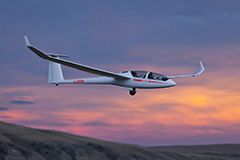Gliders
A glider is a fixed-wing aircraft that is supported in flight by the dynamic reaction of the air against its lifting surfaces, and whose free flight does not depend on an engine. Most gliders do not have an engine, although motor-gliders have small engines for extending their flight when necessary by sustaining the altitude (normally a sailplane is on a continuously descending slope) with some being powerful enough to take off self-launch .
 There is a wide variety of types differing in the construction of their wings, aerodynamic efficiency, location of the pilot, controls and intended purpose. Most exploit meteorological phenomena to maintain or gain height. Gliders are principally used for the air sports of gliding, hang gliding and paragliding. However some spacecraft have been designed to descend as gliders and in the past military gliders have been used in warfare. Some simple and familiar types of glider are toys such as the paper plane and balsa wood glider.
There is a wide variety of types differing in the construction of their wings, aerodynamic efficiency, location of the pilot, controls and intended purpose. Most exploit meteorological phenomena to maintain or gain height. Gliders are principally used for the air sports of gliding, hang gliding and paragliding. However some spacecraft have been designed to descend as gliders and in the past military gliders have been used in warfare. Some simple and familiar types of glider are toys such as the paper plane and balsa wood glider.
Early pre-modern accounts of flight are in most cases difficult to verify and it is unclear whether each craft was a glider, kite or parachute and to what degree they were truly controllable. Often the event is only recorded a long time after it allegedly took place. A 17th-century account reports an attempt at flight by the 9th-century poet Abbas Ibn Firnas near Cordoba, Spain which ended in heavy back injuries.
The monk Eilmer of Malmesbury is reported by William of Malmesbury (c. 1080–1143), a fellow monk and historian, to have flown off the roof of his Abbey in Malmesbury, England, sometime between 1000 and 1010 AD, gliding about 200 metres (220 yd) before crashing and breaking his legs. According to these reports, both used a set of (feathery) wings, and both blamed their crash on the lack of a tail. Hezârfen Ahmed Çelebi is alleged to have flown a glider with eagle-like wings over the Bosphorus strait from the Galata Tower to Üsküdar district in Istanbul around 1630–1632. More details
 There is a wide variety of types differing in the construction of their wings, aerodynamic efficiency, location of the pilot, controls and intended purpose. Most exploit meteorological phenomena to maintain or gain height. Gliders are principally used for the air sports of gliding, hang gliding and paragliding. However some spacecraft have been designed to descend as gliders and in the past military gliders have been used in warfare. Some simple and familiar types of glider are toys such as the paper plane and balsa wood glider.
There is a wide variety of types differing in the construction of their wings, aerodynamic efficiency, location of the pilot, controls and intended purpose. Most exploit meteorological phenomena to maintain or gain height. Gliders are principally used for the air sports of gliding, hang gliding and paragliding. However some spacecraft have been designed to descend as gliders and in the past military gliders have been used in warfare. Some simple and familiar types of glider are toys such as the paper plane and balsa wood glider.Early pre-modern accounts of flight are in most cases difficult to verify and it is unclear whether each craft was a glider, kite or parachute and to what degree they were truly controllable. Often the event is only recorded a long time after it allegedly took place. A 17th-century account reports an attempt at flight by the 9th-century poet Abbas Ibn Firnas near Cordoba, Spain which ended in heavy back injuries.
The monk Eilmer of Malmesbury is reported by William of Malmesbury (c. 1080–1143), a fellow monk and historian, to have flown off the roof of his Abbey in Malmesbury, England, sometime between 1000 and 1010 AD, gliding about 200 metres (220 yd) before crashing and breaking his legs. According to these reports, both used a set of (feathery) wings, and both blamed their crash on the lack of a tail. Hezârfen Ahmed Çelebi is alleged to have flown a glider with eagle-like wings over the Bosphorus strait from the Galata Tower to Üsküdar district in Istanbul around 1630–1632. More details
